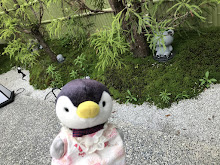The highlights of Kyoto's Ninen-zaka and Sannei-zaka
Both Ninen-zaka and Sannei-zaka are part of the approach to Kiyomizu-dera Temple. It is said that the road has been gradually gained popularity since it was maintained around 800. The current townscape was set up in the early Taisho era, and at the same time the houses were neatly lined. It is designated as a preservation area for important traditional buildings. Not to mention sightseeing spots such as Kiyomizu-dera Temple, Kodai-ji Temple and Yasaka Pagoda, the townscape around Ninen-zaka and Sannei-zaka is a place where you can feel the atmosphere of Kyoto no matter where you are. There are many tourists who wear kimono and enjoy taking photos.About the name of Sannei-zaka and Ninen-zaka
Hideyoshi Toyotomi's wife, Nene, was stayed at Kodai-ji Temple and it was said that she went up a hill to visit Kiyomizu-dera wished to have a baby. Therefore, the hill was named Sannei (san = birth, nei = wish). Sannei also can be written "three years". Ninnen-zaka (2 years) is under Sannei-zaka, so it seems to be called.A panoramic point of Yasaka pagoda
If you go straight, without going down the stairs from Sannei-zaka to Ninnen-zaka, you will see Houkan-ji five-storied Pagoda, the symbolic presence of Kyoto Higashiyama, commonly known as Yasaka Pagoda. Houkan-ji itself is not a major tourist attraction and does not have a high level of recognition, but if you say "Yasaka pagoda", it will be recognized enough! On both sides of the road, typical Japanese-style buildings are lined and it makes up a wonderful view.Old legend has it that...
The legend that 〝if you stumble and fall on Ninen-zaka you will die within 2 years" and "if you stumble and fall on Sannei-zaka you will die within 3 years" It is thought that the phrase saying "Be careful with cobblestone road". The cobblestone stairs are a bit steep, so be careful when stepping on the road when it is wet with rain or visiting with a kimono or Yukata.
If you want to eat Kyoto's specialties ...Okutan
It is a well-established restaurant founded in 1635, early in the Edo period, where you can enjoy vegetarian dishes centered on boiled-tofu. The history and taste passed down from generation to generation can be felt from the atmosphere of the store. From the rooms, you can enjoy watching the spacious Japanese garden in each season, so it is an excellent atmosphere where you can enjoy the Japanese meal.In the cold season, hot tofu buns are sold outside the store. Soy milk and tofu are kneaded, and vegetable is wrapped. It is good for eating on a cold day.
Cute Hello Kitty sweet house "Hello Kitty Saryo"
In Ninen-zaka, there is a tea house of the Sanrio character "Hello Kitty", which has a lot of fans not only in Japan but also around the world. As a shop that introduces Japanese tea culture to the world, they serve sweets and meals that have a character of Hello Kitty. Enjoy the world of Hello Kitty while feeling and touching the traditions of Kyoto. This is a tea house where foreigners can easily enjoy tea.





Find best souvenirs of Kyoto!
Especially in Sannei-zaka, there are many souvenir shops that sell traditional Japanese goods such as accessories, Chirimen Sansho, Shichimi pepper and Japanese sweets. The shops were made use of old-style Japanese house and you can feel the traditional atmosphere of Japanese town.





















No comments:
Post a Comment